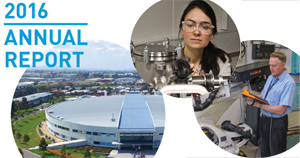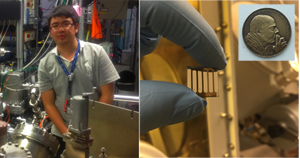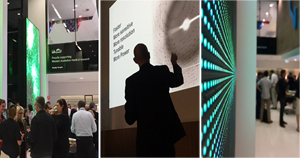- Details
It has been a year like no other at the Australian Synchrotron; 2016 saw the securing of $520 million over ten years in operational funding in December 2015 and the transfer of ownership to the Australian Nuclear Science and Technology Organisation (ANSTO) in July 2016, while hosting 5,700 visits by researchers from across Australia, New Zealand and around the world.
In a year that also saw celebrations of ten years since ‘First Light’, the landmark research infrastructure continued to empower researchers and industry to problem solve and innovate, supporting the delivery of real life benefits including durable, rapidly-printable electronics; next-generation batteries that run on sea water; non-invasive brain electrodes to help overcome paralysis; and ‘stainless magnesium’ that could herald a transport revolution.
Looking forward to a new era as part of ANSTO’s world-class suite of landmark research infrastructure, the future looks even brighter. In 2017 and beyond additional capacity and new capability will be realised through nationwide partnerships under the BR-GHT expansion program, enabling the rapid progression of research by harnessing the power of eight new synchrotron techniques.
Download link:
- Details
Left: Dr Wenchao Huang with his PhD supervisor, Associate Professor Chris McNeill from the Faculty of Materials Science and Engineering at Monash University; right: an organic solar cell; inset: the Australian Synchrotron Stephen Wilkins Thesis Award medal.
A young Melbourne researcher has helped lay the groundwork for an environmentally-friendly electronics revolution, defining the complex chemistry that could see affordable, translucent, printable solar panels moulded and shaped to adorn home windows and office towers.
Dr Wenchao Huang today received the 2016 Australian Synchrotron Stephen Wilkins Thesis Medal for his research at Monash University into organic photovoltaic (OPV) devices, exploring how critical microstructural features evolve during the preparation of cutting-edge, clear and pliable solar panels, which are tipped to surpass older, silicon-based panels in value and performance over the next decade.
Associate Professor Chris McNeill from the Faculty of Materials Science and Engineering at Monash University says Dr Huang’s research balanced the activity of two key solar panel components.
‘In the active layer of a polymer solar cell you have the polymer donor – which absorbs sunlight and generates electron-hole pairs – and the fullerene acceptor, which transports electrons to electrodes.
‘Under different circumstances, the polymer can become crystallised, which makes charge transport and light absorption more efficient, but reduces the probability that electrons will be successfully transferred to the fullerene, which has a negative effect on power conversion efficiency; experimenting with heat treatment and additive solvents, Wenchao used the Australian Synchrotron’s Soft X-Ray Spectroscopy (SXR) beamline to find a workable balance that we believe will make OPV’s more commercially viable.’
Dr Huang, who has since winged his way to new opportunities in the United States at the University of California, Los Angeles, says the key to bringing next-generation solar cells into our homes and workplaces is maximising the power conversion efficiency.
‘Silicon has had a huge head start – coming into play in the 1950s while organic solar cells appeared in the mid-1990s – yet commercialised single-crystal silicon solar cells convert around 18-20 per cent of energy from the sun into power, next to 12 per cent for organic.
‘We anticipate it will be only years, not decades, until organic takes the lead, costing around half or one third to produce.’
Associate Professor McNeill says the team at the Australian Synchrotron provided crucial molecular analysis as broader techniques of the ongoing research were developed, which could impact Australia’s green energy future.
‘We believe the upscaling of OPV’s will enable faster development of next-generation solar panels and electronics that are flexible, malleable and more affordable, beyond the limitations of bulky silicon-based electronics.
‘The ability to incorporate solar panels into clear windows on houses, skyscrapers and stadiums is a very attractive prospect as Australia works towards a sustainable energy mix that maintains output and reliability while lowering carbon emissions.’
Professor Andrew Peele, Director of the Australian Synchrotron and ANSTO Victoria, says through research opening up new pathways for innovation that deliver real life benefits, Dr Huang is a worthy recipient of the medal, which is named in honour of synchrotron pioneer Stephen Wilkins.
‘Science is about turning big ideas into innovations that change our world, and Wenchao has embodied this spirit by tackling a complex technical issue using synchrotron science in a way that could revolutionise affordable, renewable energy.
‘The thesis medal honours Stephen Wilkins’ creativity and his devotion to nurturing the next generation of scientists, and we wish Wenchao well as he builds his career in the United States.’
The Australian Synchrotron Stephen Wilkins Thesis Medal is awarded annually to the PhD student at an Australian or New Zealand university judged to have completed the most outstanding thesis of the past two years, and whose work was undertaken at and acknowledges the Australian Synchrotron or the Australian National Beamline Facility.
- Details
It was a fittingly sunny afternoon to discuss the power of light when around 130 people, from confessed computing experts to young scientists of the future, gathered in Perth last week to learn how big data and big ideas are translated into real life benefits by experts at the Australian Synchrotron and across the Australian Nuclear Science and Technology Organisation (ANSTO)’s suite of world-class landmark research infrastructure.
At the ‘Big data + big ideas = real-life benefits’ lecture, Australian Synchrotron Director Professor Andrew Peele showed dazzling rich-colour images that shed insight into the mind-bending computing behind the real-life benefits delivered through the Australian Synchrotron: from peeling back the surface of priceless artworks to de-clogging inkjet printers, and from enriching the nutrients in essential foods to pharmaceutical breakthrough that are changing the lives of people with cancers and coeliac and Alzheimer’s diseases.
Embarking on a ‘deep dive’ into the mechanics of big data, Dr Andreas Moll, Senior Scientific Software Engineer, took the audience through the creation of a one gigapixel image, from data collection and processing to stitching and reconstruction. Incredibly, Dr Moll told guests that technical upgrades to key equipment on one of the facility’s ten beamlines will see data acquisition that currently takes 15 minutes, reduced to only 18 seconds accelerating health and medical research.
In a further nod to the future, Professor Peele explained how advances in synchrotron technology are rapidly outpacing increases in the speed of conventional computing devices, paving the way for new investment at the landmark research facility that will massively expand the ability of Australian Synchrotron scientists to translate its torrents of data into improvements in the way we work, eat and live, through partnership with academic researchers and industry clients from across Australia, New Zealand and around the world.
Hosted by Dr Erica Smyth, Deputy Chair of ANSTO and Chair of the WA Mega Data Cluster and emceed by Dr Miles Apperley, Head of Research Infrastructure at ANSTO, the lecture left a buzz in the air at the Harry Perkins Institute of Medical Research with one guest describing the display of technical know-how as ‘brain-blasting’.
Click here to download the 'Big ideas + big data = real life benefits' presentation.



